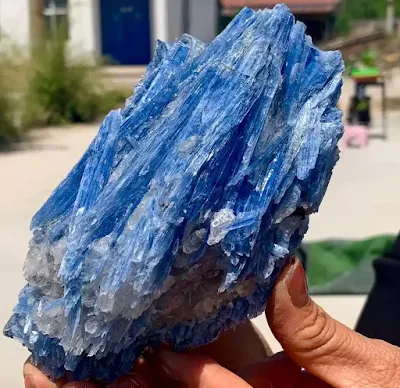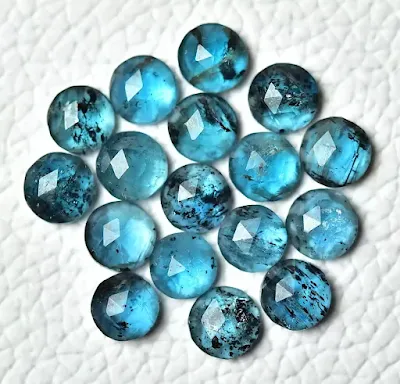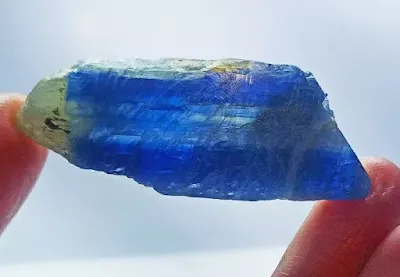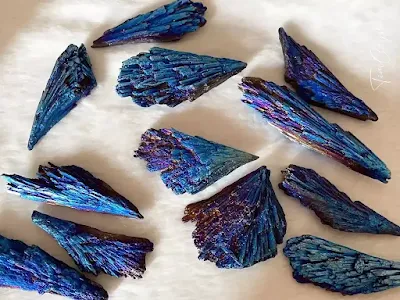Kyanite: Properties, Occurrence, Uses
Kyanite is a blue-colored mineral known for its variable hardness and use in industrial applications like making high-heat-resistant materials and, sometimes, as a gemstone.
What is kyanite
Kyanite is a beautiful blue mineral that is typically found in metamorphic rocks. It is an aluminum silicate mineral, with the chemical formula Al₂SiO₅. Kyanite is known for its bladed crystals, which can be long and slender. It belongs to the aluminosilicate group of minerals, which also includes sillimanite and andalusite.
The blue color of kyanite is typically attributed to trace amounts of iron and titanium within the crystal structure. Different impurities or conditions during formation can contribute to variations in color, including green, gray, or colorless varieties.
 |
| Kyanite is a blue-colored mineral. |
Kyanite is an anisotropic mineral, meaning its hardness varies depending on the direction you scratch it. Scratching it parallel to the long axis (the blade direction) will yield a hardness of 4.5 to 5.5 on the Mohs scale (relatively soft), while scratching it perpendicular to the long axis can be as high as 6 to 7 (much harder). This dramatic difference is quite rare in minerals.
The name "kyanite" is derived from the Greek word "kyanos," which means blue, reflecting the common blue color of this mineral.
Properties of Kyanite
Composition: Kyanite Al₂SiO₅ is an aluminosilicate mineral, composed of aluminum, silicon, and oxygen.
Kyanite Physical Properties
- Color: Kyanite is typically blue, but it can also be found in rare colors like green, gray, or colorless varieties. The blue color is caused by trace amounts of iron and titanium. Can show zones or patches of different colors.
- Transparency: Kyanite is usually transparent to translucent.
- Luster: The luster of kyanite is vitreous to pearly.
- Crystal System: Kyanite crystallizes in the triclinic crystal system.
- Streak: The streak of kyanite is white.
- Hardness: Kyanite is a relatively hard mineral with a hardness ranging from 4.5 to 7 on the Mohs scale, depending on the crystallographic direction. This anisotropic hardness is a unique property of kyanite.
- Cleavage: Kyanite exhibits perfect cleavage parallel to its long, bladed crystals.
- Fracture: The fracture of kyanite is uneven.
- Habits and Forms: Kyanite typically occurs as long, bladed crystals. It may also be found in fibrous or compact aggregates.
- Density: The density of kyanite ranges from 3.53 to 3.70 g/cm³.
- Specific Gravity: The specific gravity of kyanite ranges from 3.6 to 3.7.
- Solubility: Kyanite is generally insoluble in common acids and bases.
- Magnetism: Kyanite is not magnetic.
Kyanite Optical Properties
- Fluorescence: Kyanite is usually non-fluorescent.
- Pleochroism: Kyanite often exhibits strong pleochroism, meaning it can display different colors when viewed from different angles. In the case of blue kyanite, it may show lighter and darker shades of blue or even greenish tones.
- Refractive Index: The refractive index of kyanite ranges from approximately 1.712 to 1.734.
Additional Kyanite Properties
- Inclusions: Kyanite may contain inclusions or impurities that can affect its color and appearance. These inclusions may include mineral inclusions or other materials.
- Best Field Indicators: Long bladed crystals, distinctive blue color, anisotropic hardness, perfect cleavage, and pleochroism are key indicators of kyanite in the field.
 |
| Kyanite crystals in white quartz |
Occurrence: Where is kyanite found?
Kyanite is a metamorphic mineral that typically occurs in high-grade (high-pressure and medium to high-temperature environments) metamorphic rocks, such as schists and gneisses. These rocks are formed when subjected to extreme temperature and pressure conditions, which cause the original minerals in the rock to recrystallize into new forms. Kyanite is particularly diagnostic of the blueschist facies of metamorphic rocks, which are formed under high pressure and moderate to low temperature conditions. These conditions are commonly found in mountain ranges that have undergone intense tectonic activity and mountain-building processes.
Kyanite is a relatively rare mineral, but it is found in many parts of the world, including the Himalayas, the Alps, and the Appalachian Mountains.
Kyanite can also be found in some igneous rocks, such as granites and pegmatites, and even in certain types of sedimentary rocks. However, it is less common in these rock types.
Mineral associations: Kyanite is frequently found alongside other metamorphic minerals, including staurolite, garnet, and andalusite. These minerals often form together in the same rock types.
Countries where kyanite mines can be found
India: The Himalayas are home to some of the world's largest kyanite deposits. Kyanite is mined in the states of Jammu and Kashmir, Himachal Pradesh, and Uttarakhand.
USA: Kyanite deposits are found in the Appalachian Mountains, particularly in Virginia, North Carolina, and South Carolina. The Manhattan Schist, formed under extreme pressure during the assembly of the supercontinent Pangaea, is another location where kyanite can be found in the USA.
Brazil: Minas Gerais is a state in southeastern Brazil. It is home to a variety of mineral deposits, including kyanite. The kyanite mines in Minas Gerais are some of the largest in the world.
Switzerland: Pizzo Forno is a mountain located in the Swiss canton of Graubünden. It is known for its spectacular kyanite deposits, which have produced some of the finest specimens of kyanite in the world.
Austria: Kyanite is found in the Alps of Austria.
 |
| Cut Kyanite gemstones |
Kyanite Uses and Applications
Kyanite has several uses and applications, primarily in industrial and jewelry-related fields:
Refractories: High-Temperature Resistance, Kyanite's star quality is its exceptional resistance to heat. This makes it ideal for manufacturing refractory materials. These are special heat-resistant products used in high-temperature environments like furnaces, kilns, and glass manufacturing. Kyanite is used in refractory bricks, castables, and other components that can withstand intense heat without breaking down.
Ceramics: Kyanite strengthens and improves the thermal resistance of ceramics, allowing them to be fired at high temperatures. This makes it a valuable ingredient in porcelain and fine china production.
Abrasives (less common): In some cases, kyanite's hardness and durability make it suitable for grinding wheels, cutting tools, and sandpaper. However, other minerals like corundum are more commonly used for abrasive applications.
Other Industrial Uses: Kyanite's unique properties also make it applicable in spark plugs (the porcelain insulator), automotive and railroad components requiring heat resistance, and even some high-strength porcelain used in dentures, sinks, and bathroom fixtures.
Jewelry: Despite its industrial uses, kyanite's beauty makes it a desired gemstone. Here's what makes it appealing:
- Colors: Kyanite comes in various colors, most notably blue (reflecting the sky's color) and green. Black kyanite is also found.
- Cutting and Use: Due to its distinct cleavage ( tendency to break in a specific direction), kyanite is usually cut into cabochons (smooth, polished stones) or beads. Jewelry designers may incorporate it into necklaces, earrings, or bracelets.
It's important to note that kyanite can have a bladed structure, making it prone to splitting or breaking if struck with a sharp blow. Jewelers need to be aware of this property when cutting and working with kyanite.
 |
| Kyanite Crystals From Brazil |
Aura Peacock Kyanite
Aura Peacock Kyanite is a beautiful gemstone created by bonding natural Kyanite with titanium through a special heating process. This process gives the Kyanite a stunning iridescent sheen with vibrant peacock colors, making it a popular choice for jewelry and crystal healing.
The most striking feature of Aura Peacock Kyanite is its iridescent play of color. It displays blues, greens, yellows, and sometimes even hints of purple and red, depending on how the light hits the stone.
Treated Aura Peacock Kyanite is not a natural stone. The titanium treatment creates a permanent alteration to the surface of the Kyanite.
 |
| Transparent kyanite crystal |
Kyanite FAQ
How is kyanite different from other minerals like andalusite and sillimanite?
A: Kyanite, andalusite, and sillimanite are all members of the aluminosilicate mineral group. One key difference is their crystal structures and the resulting anisotropic properties. Kyanite has a unique triclinic crystal structure, while andalusite and sillimanite have different crystal structures. Additionally, their physical properties, such as hardness, vary depending on the direction in which they are measured.
 |
| TREATED Aura Peacock Kyanite |
What are some metaphysical benefits of Kyanite?
A: Here's a breakdown of kyanite's benefits based on folklore and tradition:
Emotional and Spiritual Benefits:
- Peace and Harmony: Kyanite is believed to promote feelings of peace, tranquility, and emotional balance.
- Communication and Self-Expression: It's thought to aid clear communication and self-expression, helping you speak your truth.
- Stress Reduction and Emotional Healing: Some believe kyanite can help reduce stress, anxiety, and negative emotions.
Other Traditional Benefits:
- Spiritual Growth: Kyanite is associated with spiritual development and attunement.
- Dream Recall: It's believed to improve dream recall, allowing you to access the insights your dreams offer.
- Physical Healing: In traditional practices, kyanite is associated with healing for the throat, muscles, and nervous system.
Is Kyanite a birthstone?
A: Kyanite is not a traditional birthstone for any particular month.
Is Kyanite the national gemstone of any country?
A:Yes, Kyanite is the official national gemstone of Finland.
In the kaleidoscope of gemstones, kyanite shines with its distinctive properties, intriguing occurrence, and diverse applications. From its formation deep within the Earth to its emergence in jewelry and industrial processes, kyanite continues to captivate enthusiasts and industry professionals alike. As we uncover more about this remarkable gem, its allure and significance are destined to grow, solidifying its place in the fascinating world of minerals and gemology.



%20(1).webp)




